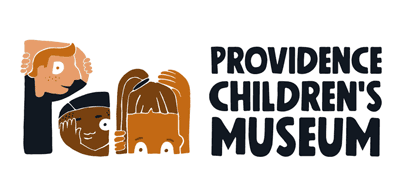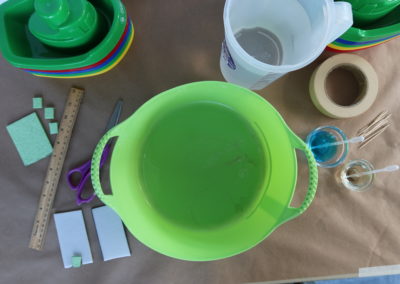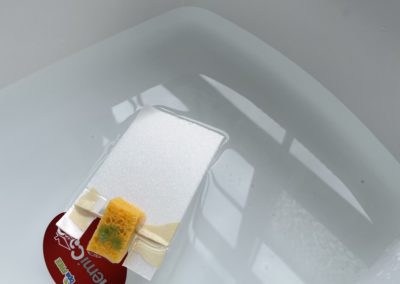Let’s Learn A-Boat Surface Tension
Developed by Mary Nordby, PCM Play Intensive 2021
(FOCUS: grades 3 and 4, STEM, Executive Function, Next Generation Science Standards)
This grades 3-4 STEM activity introduces children to the properties of water while using steps of The Engineering Design Process: Ask, Imagine, Plan, Create, Test, and Improve.
“Let’s Learn A-boat Surface Tension” encourages students to experiment with various substances and analyze their effects on the surface tension of water. They will utilize no-cost and readily available materials to work with their peers, families, and teachers to create a boat that uses surface tension to propel it across the surface of a container of water. Experiments such as this promote critical thinking skills, foster scientific reasoning, and encourage cooperation and perseverance.
Although it is not always evident, we use The Engineering Design Process when we solve problems every day.
Materials
- Dehydrated and compressed kitchen sponges (2 or 3)
- Scissors
- Metric ruler (optional)
- Permanent marker (optional)
- Styrofoam take-out container (1 or 2)
- Toothpicks
- Tape
- Large basin or sink
- Water
- Eye dropper
- Blue dish soap
- At least 3 other household substances to test (ex. Vegetable oil, salt, laundry detergent)
- Data collection notebook
Set Up
Fill a large basin or sink with water. It should be large enough for your boat to travel a short distance. If you are using a basin, be sure you are in a place you can easily fill, empty, and refill it, such as in or near a bathtub or sink, or outdoors near a water hose or spigot.
To construct your boat, cut a sponge into squares that are roughly the same size. You may want to use an additional sponge to experiment with finding the cutting technique that works best for you. For more precise results you may want to use a ruler and a permanent marker to draw a grid with squares of 1.5 to 2 centimeters.
Cut the Styrofoam into a 10 centimeter by 5 centimeter rectangle. Ask an adult for help if necessary. In the middle of the short edge, cut out a rectangle that is half a centimeter larger than your sponge pieces.
Lay one of your sponge squares flat and insert a toothpick horizontally, so that an equal amount of the toothpick protrudes from each side of the sponge. Insert the sponge into the Styrofoam square you cut out of the back of your boat. The sponge should able to rest upon the surface of the water. Tape each end of the toothpick to the boat to hold the sponge in place.
Student’s Job
Work with a partner to determine which household substances will propel your boat by reducing the surface tension of the water.
- Fill the sink or basin with enough water to float your boat, leaving enough room for it to move forward.
- Using the eye dropper, place 2 drops of blue dish soap on your sponge.
- Use your ruler to measure the distance your boat moved.
- Record your findings in your science notebook. You’ll want to list the household substance, if the boat moved, and the distance the boat traveled.
- Empty the basin and repeat steps 2-4, making sure to use a clean sponge.
- Your boat traveled forward because the soap reduced the surface tension of the water. In your notebook, list the other substances you will be using to try to propel your boat. For each substance, predict which ones will reduce the water’s surface tension, propelling your boat forward.
- Repeat steps 2-5 twice for each substance, recording your results in your science notebook.
Further Challenges:
How does the shape of the boat affect the distance it travels? How does the size of the boat affect the distance it travels? what you’ve learned about how shape and size affect the distance traveled, design a boat that you think will travel the greatest distance. Does the temperature of the water change which substances reduce the surface tension of the water?
Teacher’s Job
- Observe students as they work, looking for evidence of understanding. Do the children understand why the boat is or is not propelled forward?
- Are the students using the Engineering Design Process?
- Are the students taking careful notes and recording their observations in their notebooks?
- Connect their learning to the real world by introducing them to a related career in STEM: Physicist
Standards Alignment
NEXT GENERATION SCIENCE STANDARDS: ENGINEERING DESIGN
3-5-ETS1-3: Plan and carry out fair tests in which variables are controlled and failure points are considered to identify aspects of a model or prototype that can be improved.
ETS1.C: Optimizing the Design Solution: Different solutions need to be tested in order to determine which of them best solves the problem, given the criteria and the constraints.
NEXT GENERATION SCIENCE STANDARDS: EARTH & HUMAN ACTIVITY
3-ESS3-1: Make a claim about the merit of a design solution that reduces the impacts of a weather-related hazard.
Connections to previous work?
FOSS Water and Climate Module
Prepare/ Background Info
- Front load the students with a discussion about surface tension. What is it? What do they know about it?
- When you have a container full of water, the water molecules below the surface are pulled together equally in all directions, but those on top are pulled together more tightly, as they don’t have water molecules above them. This draws them together to form a kind of “skin”, which we call surface tension.
- Introduce and/or review the Engineering Design Process.
Facilitation Strategies
Praise effort and perseverance. Encourage children to make predictions before testing each substance. Ask open-ended questions. For example, “Tell me why you think that happened.”
Play to Notice
Cooperative, independent, engaged, problem-solving.
Are the students engaged in cooperative play, as evidenced by back and forth discussion, sharing of resources, and division of labor?
Content Matter to Notice
- Observe students as they work, looking for evidence of understanding. Do the children understand why the boat is or is not propelled forward?
- Are the students using the Engineering Design Process?
- Are the students taking careful notes and recording their observations in their notebooks?
SEL to Notice
Decision making, perseverance, cooperation, respect, tolerance, self-management, self-awareness. Are the students actively listening to each other’s ideas? Are the students able to resolve differences harmoniously? Is everyone participating?
Photo Gallery & Additional Resources
EDP Rap (Engineering Design Process)




0 Comments